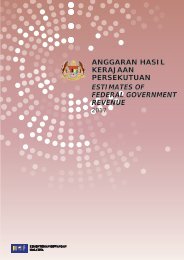WEALTH
2c0esX1
2c0esX1
You also want an ePaper? Increase the reach of your titles
YUMPU automatically turns print PDFs into web optimized ePapers that Google loves.
MACRO<br />
García-Herrero has one of those CVs that make<br />
you feel you’ve wasted your life. In addition to<br />
her day job, she serves as senior research fellow<br />
at the European think tank BRUEGEL, nonresident<br />
fellow at Cornell’s emerging market<br />
research center, and is adjunct professor at<br />
City University, Hong Kong. Among her other<br />
credits, she has had stints as chief economist<br />
for Emerging Markets at Banco Bilbao Vizcaya<br />
Argentaria (BBVA), at the Bank of International<br />
Settlements (BIS), and as a member of the<br />
Counsel to the Executive Board of the European<br />
Central Bank, as well as at the International<br />
Monetary Fund.<br />
THE SKY IS NOT FALLING<br />
For her, it is inevitable – barring massive social<br />
unrest or war – that China will not only double<br />
its economy by 2020 (over 2010 and in line with<br />
Beijing’s ambitious goals), but that it will again<br />
double it by 2050. This is despite the country’s<br />
posting in 2015 its worst GDP growth (6.9%) in<br />
25 years. But then she has little time for<br />
Chicken Little hedge funds in London or New<br />
York. The simplified market equation that<br />
assesses Chinese growth of xx.x% (insert your<br />
preferred number) as resulting in either<br />
economic stability or chaos, dodges the hard<br />
work and time required to analyze the<br />
complexities of modern China.<br />
“Deeper scrutiny shows Chinese policies<br />
can preserve economic stability in the<br />
transformation to a more sustainable economic<br />
growth model,” she explains. “But that doesn’t<br />
mean it’s all rosy, because the way China<br />
has doubled its income in the past is no<br />
longer available.”<br />
The way she sees it is that 2016 will be<br />
crucial for China. The country is shifting<br />
growth away from investment to consumption,<br />
and its industrial base from basic manufacturing<br />
to a medium-high technology level. But this is<br />
occurring at a time when one of the engines of<br />
growth, urbanization, is losing strength.<br />
Over the past three decades, China<br />
witnessed the biggest movement of humanity<br />
seen in such a short period. More than 500<br />
million people left the countryside; China’s<br />
cities, now home to more than half the<br />
country’s 1.35 billion people, are still growing<br />
by the population of Belgium (11.3 million)<br />
every year. However, this movement is slowing: roughly 70% of those that<br />
will move have done so already. While 300–400 million may still shift,<br />
the structural growth provided by urbanization is weakening.<br />
“What we can expect for the next five years for China is cloudier than<br />
what we have seen in the last five,” she reflects. Growth in China will be<br />
slower, and rightly so, because that is the price that must be paid for<br />
higher consumption ratios. As policy makers try to rebalance demand,<br />
they cannot afford to reproduce the high growth rates of the past<br />
because of an aversion to inflation.<br />
OUT TO 2050<br />
On a purchasing power parity basis, China is already the world’s largest<br />
economy (at $19.92 trillion) and García-Herrero doesn’t expect this to<br />
change. By 2050, she believes China will be far richer, that it will still be<br />
the largest economy, but that it will also be extremely old. “China will<br />
age dramatically,” she notes. “The labor force will decrease rapidly from<br />
2016 onwards. From then on, more people will retire than enter the<br />
workforce. By 2040, its population is projected to be 1.4 billion and China<br />
will have 420 million over the age of 60, the majority of them retired.”<br />
Such adverse demographics (see pages 52–53) will reduce potential<br />
growth, she argues. As today’s older workers retire, and society finds too<br />
few younger ones to replace them, this will commence a vicious circle of<br />
rising wages, declining demand and deteriorating saving rates that will<br />
also bring potential growth down.<br />
Whether the economic power that China accumulates by then will<br />
be enough to fund its growing pension and healthcare costs is an open<br />
question and one that the country is scrambling now to address. With<br />
China unlikely to be still running a currency surplus, García-Herrero<br />
believes it will be forced to borrow abroad to support its dependents,<br />
which it should do easily as the renminbi will be firmly established as<br />
an international currency.<br />
But then, as she willingly concedes, pundits such as herself have<br />
been wrong in the past even on their short-term calls. China is just that<br />
sort of place.<br />
CHINA’S SLOWING ECONOMY<br />
GDP growth<br />
16%<br />
14%<br />
12%<br />
10%<br />
8%<br />
6%<br />
4%<br />
1992<br />
2001<br />
China joins<br />
WTO, firing up<br />
export-led<br />
growth<br />
1994<br />
1996<br />
Source: bloomberg.com<br />
1998<br />
2007<br />
Boom times as<br />
exports meet<br />
property<br />
investment surge<br />
20 0 0<br />
20 02<br />
2009<br />
Exports<br />
plunge on<br />
global<br />
recession<br />
20 0 4<br />
20 06<br />
20 08<br />
2010<br />
Infrastucture<br />
investment<br />
surge spurs<br />
pickup<br />
2010<br />
2012<br />
2014<br />
2015<br />
Market<br />
wobbles and<br />
debt overhang<br />
cloud outlook<br />
2016<br />
Allianz • 51



